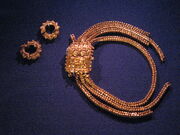Wang Dayuan (simplified Chinese: 汪大渊, fl. 1311–1350) was a traveller from Quanzhou, China during the Mongol Yuan dynasty in the 14th century. He made two major trips on ships. During 1328–1333, he sailed along the South China Sea and visited many places in Southeast Asia and reached as far as South Asia, landing in Bengal, Sri Lanka and India. In 1334–1339 he visited north Africa and East Africa.[1]
Around 1330, Wang visited the island of Singapore, where he wrote about a small settlement called Danmaxi (淡马锡, from Malay Temasek) with Malay and Chinese residents. His account of his travel, Daoyi Zhilüe Guangzheng Xia (島夷誌略),[2] dated 1349, is one of the few records documenting the early history of Singapore.
In this work, Wang described Long Ya Men as the two hills of Temasek that looked like "Dragon's teeth" between which a strait runs, and wrote about the place:
"The fields are barren and there is little padi ... In ancient times, when digging in the ground, a chief came upon a jewelled head-dress. The beginning of the year is calculated from the [first] rising of the moon, when the chief put on this head-gear and wore his [ceremonial] dress to receive the congratulations [of the people]. Nowadays this custom is still continued. The natives and Chinese dwell side by side. Most [of the natives] gather their hair into a chignon, and wear short cotton bajus girded about with black cotton sarongs."
(Translation by Paul Wheatley)[1].
Full original text:
門以單馬錫番兩山,相交若龍牙狀,中有水道以間之。田瘠稻少。天氣候熱,四五月多淫雨。俗好劫掠。昔酋長掘地而得玉冠。歲之始,以見月為正初,酋長戴冠披服受賀,今亦遞相傳授。男女兼中國人居之。多椎髻,穿短布衫。繫靑布捎。 地產粗降眞、斗錫。貿易之貨,用赤金、靑緞、花布、處甆器、鐵鼎之類。蓋以山無美材,貢無異貨。以通泉州之貨易,皆剽竊之物也。舶往西洋,本番置之不問。回船之際,至吉利門,舶人須駕箭稝,張布幕,利器械以防之。賊舟二三百隻必然來迎,敵數日。若僥倖順風,或不遇之。否則人為所戮,貨為所有,則人死係乎頃刻之間也。

Jewelry found at Fort Canning Hill, which was named Banzu by Wang Dayuan
Wang further mentioned that lakawood and tin was produced there and the natives traded with Chinese from Quanzhou, but Chinese junks on their way back from the Western Oceans (西洋) may be met by pirates there who attacked with two to three hundred perahus (boats).[3] Wang described another settlement on a hill behind Long Ya Men called Ban Zu (班卒), a transcription of the Malay name pancur meaning a "spring"). It is thought to be located on Fort Canning Hill, and a spring used to exist on the west side of the hill.[4] In contrast to those of Long Ya Men who were prone to piracy, the inhibitants of Ban Zu were described as honest, and they wore "their hair short, with turban of gold-brocaded satin," and were dressed in red cloth.[5] Wang also reported that the Siamese attacked Temasek a few years before he visited, but the fortified city survived the attack which lasted a month.[6] Ruins of the settlement on the hill were still visible in the early 19th century and were described by the Resident John Crawfurd. In 1928, pieces of gold ornaments dating to the mid-14th century was discovered at Fort Canning Hill.[7]
Recent excavations in Fort Canning provide evidence that Singapore was a port of some importance in the 14th century[8] and used for transactions between Malays and Chinese. Various documents suggest that following the decline of Srivijaya power, Temasek was alternately claimed by the Majapahit and the Siamese Ayutthaya Kingdom.